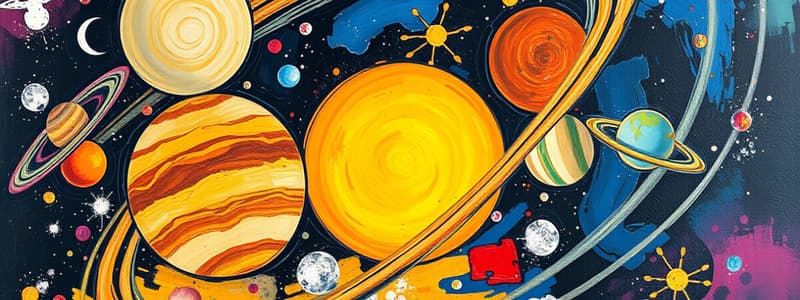Podcast
Questions and Answers
What characteristic is associated with Saturn?
What characteristic is associated with Saturn?
- Is the innermost planet in the solar system
- Has the coldest temperatures in the solar system
- Has more than 100 moons
- Possesses the largest ring system (correct)
Which of the following statements about Galileo is true?
Which of the following statements about Galileo is true?
- Improved the telescope to study Mars
- He dismissed the heliocentric model
- Observed four moons orbiting Jupiter (correct)
- Advocated for the geocentric system
What did Kepler discover about planetary orbits?
What did Kepler discover about planetary orbits?
- They are circular in shape
- They follow a linear path
- They vary in speed constantly
- They are elliptical (correct)
Which feature characterizes Mercury?
Which feature characterizes Mercury?
What did Ptolemy's geocentric model propose?
What did Ptolemy's geocentric model propose?
What is the primary distinction of Neptune among the planets?
What is the primary distinction of Neptune among the planets?
What is significant about Copernicus's contributions to astronomy?
What is significant about Copernicus's contributions to astronomy?
Which planet is recognized for having a giant storm known as the Great Dark Spot?
Which planet is recognized for having a giant storm known as the Great Dark Spot?
Which of these options describes the gravitational theory proposed by Newton?
Which of these options describes the gravitational theory proposed by Newton?
Which planet is sometimes referred to as the 'Red Planet' due to its rusted soil?
Which planet is sometimes referred to as the 'Red Planet' due to its rusted soil?
Flashcards are hidden until you start studying
Study Notes
Earth
- Only known planet to support life.
- Over 70% of its surface is covered by water.
Saturn
- Largest planet with the most impressive ring system.
- Second-largest planet in the solar system.
Neptune
- Recognized as the coldest planet.
- Features the Great Dark Spot, a storm similar to Jupiter's Great Red Spot.
Mercury
- The smallest planet and closest to the Sun.
- Innermost planet in the solar system.
Mars
- Often referred to as the Red Planet due to iron oxide (rust) on its surface.
Jupiter
- Largest planet in the solar system.
- Hosts 79 known moons and is known for the Large Red Spot, a massive storm.
Venus
- Close in size to Earth, approximately 95% as large.
- It is the brightest object in the sky after the Sun and Moon due to its thick cloud cover.
Historical Figures in Astronomy
Newton
- Discovered the law of gravity, explaining how objects attract each other.
- Gravity's strength depends on the masses involved and the distance between them.
- Demonstrated that the Sun's gravity and planetary inertia maintain celestial orbits.
Galileo
- Supported the heliocentric model, positioning the Sun at the center of the solar system.
- Enhanced telescopic technology for better observation of celestial bodies.
- Discovered four of Jupiter's moons, leading to conflicts with established views.
Kepler
- Established that planetary orbits are elliptical, not circular.
- Emphasized the interplay of inertia and gravity in maintaining orbits.
Ptolemy
- Proposed the geocentric model, placing Earth at the center of the universe.
- His framework suggested the Moon and Sun revolved around Earth.
Copernicus
- Introduced the heliocentric model, positioning the Sun at the center.
- His theories, not published until after his death, revolutionized astronomical understanding.
The Big Bang
- Occurred approximately 13.8 billion years ago, starting the universe's expansion.
- The initial state of the universe was extremely tiny and dense, leading to the formation of matter over time.
Additional Planetary Facts
Uranus
- Gas giant characterized by a cold atmosphere.
- Distance from the Sun: approximately 1.8 billion miles, with no solid surface.
Neptune
- Diameter measures 24,622 miles, about 3.9 times the size of Earth.
- Like Uranus, it has a gaseous atmosphere and cannot be landed on.
Venus
- Similar in size to Earth but has extreme temperatures and toxic atmosphere, with clouds of sulfuric acid.
Mars
- Approximately half the size of Earth, possessing a thin atmosphere with similar features but weaker gravity.
Studying That Suits You
Use AI to generate personalized quizzes and flashcards to suit your learning preferences.



